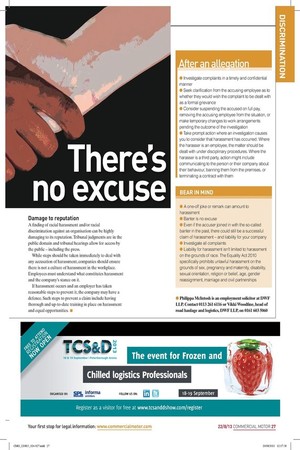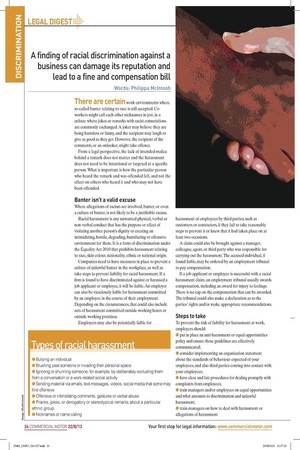A finding of racial discrimination against a business can damage its reputation and lead to a fine and compensation bill
Page 21

Page 20

If you've noticed an error in this article please click here to report it so we can fix it.
There are certain work environments where so-called banter relating to race is still accepted. Coworkers might call each other nicknames in jest, in a culture where jokes or remarks with racist connotations are commonly exchanged. A joker may believe they are being harmless or funny, and the recipient may laugh or give as good as they get. However, the recipient of the comments, or an onlooker, might take offence.
From a legal perspective, the lack of intended malice behind a remark does not matter and the harassment does not need to be intentional or targeted at a specific person. What is important is how the particular person who heard the remark and was offended felt, and not the effect on others who heard it and who may not have been offended.
Banter isn't a valid excuse
Where allegations of racism are involved, banter, or even a culture of banter, is not likely to be a justifiable excuse.
Racial harassment is any unwanted physical, verbal or non-verbal conduct that has the purpose or effect of violating another person's dignity or creating an intimidating, hostile, degrading, humiliating or offensive environment for them. It is a form of discrimination under the Equality Act 2010 that prohibits harassment relating to race, skin colour, nationality, ethnic or national origin.
Companies need to have measures in place to prevent a culture of unlawful banter in the workplace, as well as take steps to prevent liability for racial harassment. If a firm is found to have discriminated against or harassed a job applicant or employee, it will be liable. An employer can also be vicariously liable for harassment committed by an employee in the course of their employment. Depending on the circumstances, that could also include acts of harassment committed outside working hours or outside working premises. Employers may also be potentially liable for
harassment of employees by third parties, such as customers or contractors, if they fail to take reasonable steps to prevent it or knew that it had taken place on at least two occasions.
A claim could also be brought against a manager, colleague, agent, or third party who was responsible for carrying out the harassment. The accused individual, if found liable, may be ordered by an employment tribunal to pay compensation.
If a job applicant or employee is successful with a racial harassment claim, an employment tribunal usually awards compensation, including an award for injury to feelings. There is no cap on the compensation that can be awarded. The tribunal could also make a declaration as to the parties' rights and/or make appropriate recommendations.
Steps to take
To prevent the risk of liability for harassment at work, employers should: • put in place an anti-harassment or equal opportunities policy and ensure those guidelines are effectively communicated; • consider implementing an organisation statement about the standards of behaviour expected of your employees, and also third parties coming into contact with your employees; • have clear and fair procedures for dealing promptly with complaints from employees; • train managers and/or employees on equal opportunities and what amounts to discrimination and unlawful harassment; • train managers on how to deal with harassment or allegations of harassment
Damage to reputation
A finding of racial harassment and/or racial discrimination against an organisation can be highly damaging to its reputation. Tribunal judgments are in the public domain and tribunal hearings allow for access by the public — including the press.
While steps should be taken immediately to deal with any accusation of harassment, companies should ensure there is not a culture of harassment in the workplace. Employees must understand what constitutes harassment and the company's stance on it. If harassment occurs and an employer has taken reasonable steps to prevent it, the company may have a defence. Such steps to prevent a claim include having thorough and up-to-date training in place on harassment and equal opportunities. • • Investigate complaints in a timely and confidential manner • Seek clarification from the accusing employee as to whether they would wish the complaint to be dealt with as a formal grievance • Consider suspending the accused on full pay, removing the accusing employee from the situation, or make temporary changes to work arrangements pending the outcome of the investigation • Take prompt action where an investigation causes you to consider that harassment has occurred. Where the harasser is an employee, the matter should be dealt with under disciplinary procedures. Where the harasser is a third party, action might include communicating to the person or their company about their behaviour, banning them from the premises, or terminating a contract with them
' EAR IN MIND
• A one-off joke or remark can amount to harassment • Banter is no excuse • Even if the accuser joined in with the so-called banter in the past, there could still be a successful claim of harassment — and liability for your company • Investigate all complaints • Liability for harassment isn't limited to harassment on the grounds of race. The Equality Act 2010 specifically prohibits unlawful harassment on the grounds of sex, pregnancy and maternity, disability, sexual orientation, religion or belief, age, gender reassignment, marriage and civil partnerships









































